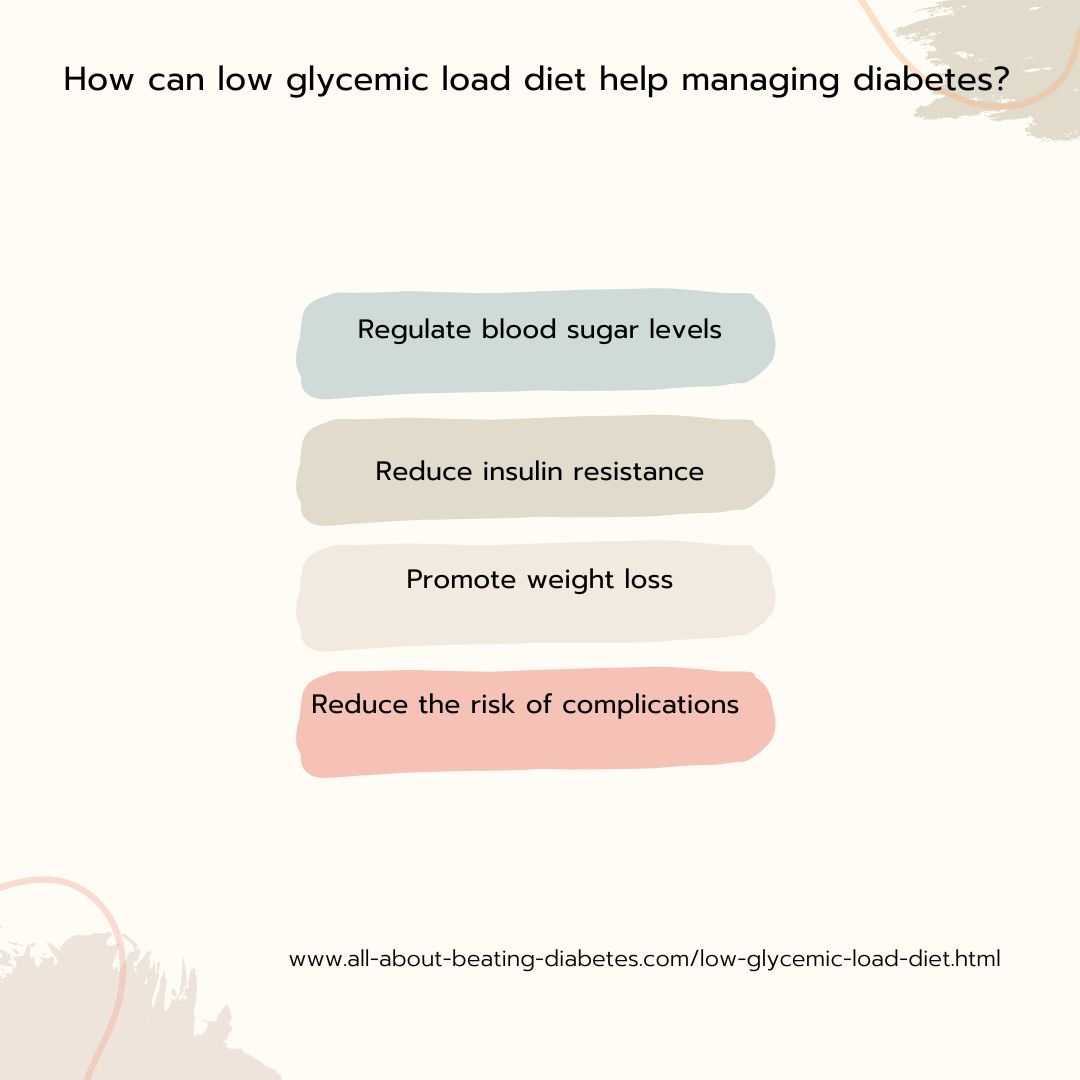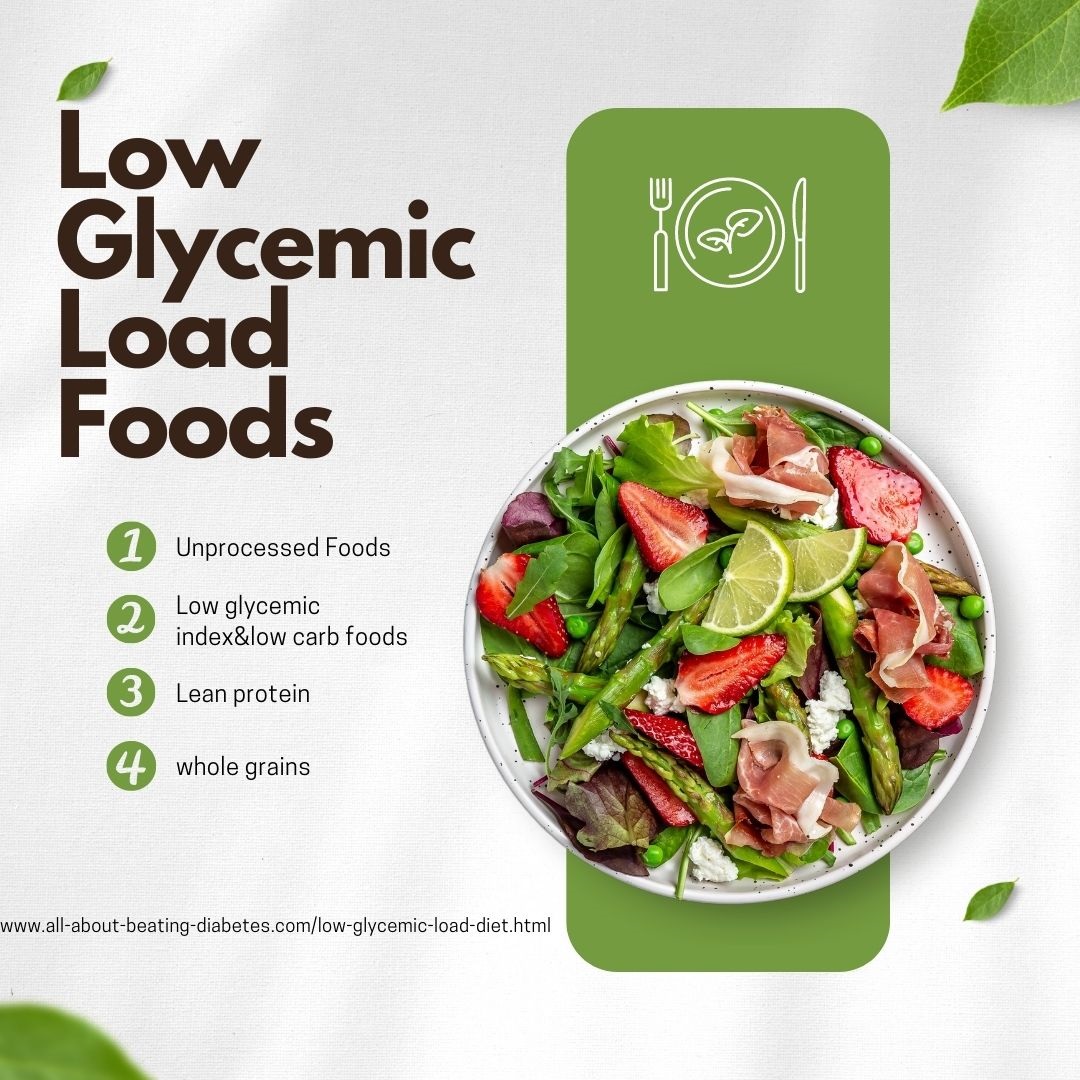How To Plan A Low Glycemic Load Diet?
- Home
- Your Diabetic Information Center
- Low Glycemic Load Diet
A low glycemic load diet involves eating foods that have a low impact on blood sugar levels, which can be beneficial for people with diabetes or those looking to manage their weight.
What is a diet of low glycemic load?
A low glycemic load diet is a way of eating that emphasizes foods that have a low impact on blood sugar levels. This type of diet may be beneficial for people with diabetes, as well as those looking to manage their weight and improve overall health.
The glycemic load is a measure of how much a particular food raises blood sugar levels. Foods with a low glycemic load have a minimal impact on blood sugar levels and can help regulate blood sugar and insulin levels in the body.
Foods with a low glycemic load typically include non-starchy vegetables such as leafy greens, broccoli, and cauliflower, as well as legumes, nuts, and seeds. Whole grains, such as brown rice, quinoa, and whole wheat bread, are also good options.
In contrast, foods with a high glycemic load, such as refined carbohydrates like white bread, sugary snacks, and sweetened beverages, can cause a rapid spike in blood sugar levels and should be limited.
A low glycemic load diet typically involves choosing foods with a low glycemic index and combining them with protein and healthy fats to slow the absorption of carbohydrates and reduce the impact on blood sugar levels.
How can low glycemic load diet help managing diabetes?
A low glycemic load diet can be helpful for managing diabetes because it can help regulate blood sugar levels and reduce the risk of complications associated with high blood sugar levels. Here are some ways a low glycemic load diet can help manage diabetes:

- Regulating blood sugar levels: By choosing foods with a low glycemic load, the rise in blood sugar levels after eating is slower and more gradual, which can help prevent spikes in blood sugar. This can help people with diabetes manage their blood sugar levels more effectively and reduce the risk of complications.
- Reducing insulin resistance: A low glycemic load diet may help reduce insulin resistance, which is a key factor in the development of type 2 diabetes. By reducing the amount of sugar in the bloodstream, the body is able to better utilize insulin to control blood sugar levels.
- Promoting weight loss: A low glycemic load diet can help with weight loss, which is important for managing diabetes. High blood sugar levels are associated with weight gain, and losing weight can help improve blood sugar control.
- Reducing the risk of complications: By helping to regulate blood sugar levels and reduce the risk of insulin resistance, a low glycemic load diet can reduce the risk of complications associated with diabetes, such as heart disease, kidney disease, and nerve damage.
To calculate the glycemic load of a food, multiply its carbohydrate content by its glycemic index and divide by 100 (Glycemic Load (of food) = (Carbohydrate Content x GI) : 100 For example, if a 100-gram serving of Corn Tortilla has a glycemic index of 52 and 48 grams of carbs, its glycemic load would be 25.
The glycemic load unit is equivalent to the effect of consuming one gram of pure glucose or white bread on blood sugar levels. Your dietary glycemic load is the sum of all the glycemic loads of the foods you eat.
Eating high glycemic index foods can cause a rapid increase in blood sugar levels, leading to reduced fat burning and lower energy levels. These foods stimulate insulin production, which stores excess sugar in the body as fat.
Excessive insulin production can cause hypoglycemia and cravings for glucose, leading to overheating and other issues. Calculating carbohydrates based on their glycemic load is important to understand how they affect blood sugar levels and the importance of a low glycemic load diet for better diabetic management.
Overall, a low glycemic load diet can be an effective way for people with diabetes to manage their condition and improve their overall health. However, it's important to work with a healthcare provider or registered dietitian to develop an individualized plan that meets your specific needs and goals.
How to plan my own diet with low glycemic loads foods?

Planning a low glycemic load diet involves choosing foods that have a lower glycemic index and a lower glycemic load. Here are some tips to help you plan your own low glycemic load diet:
- Focus on whole, unprocessed foods: Whole foods such as fruits, vegetables, legumes, and whole grains are generally lower in glycemic load than processed foods.
- Choose low glycemic index fruits and vegetables: Some examples of low glycemic index fruits include berries, cherries, grapefruit, and apples. For vegetables, choose non-starchy options such as broccoli, spinach, and bell peppers.
- Select lean sources of protein: Choose lean sources of protein such as skinless chicken, turkey, fish, and legumes.
- Opt for whole grains: Choose whole grains such as quinoa, barley, and whole wheat bread, which are generally lower in glycemic load than refined grains.
- Avoid or limit high glycemic index foods: Some examples of high glycemic index foods include white bread, white rice, sugary drinks, and processed snacks.
- Balance your meals: Aim to include a balance of carbohydrates, protein, and healthy fats in each meal to help regulate blood sugar levels and keep you feeling full and satisfied.
- to plan your meals for better blood sugar management, consider the carb content and glycemic index (GI) of the foods you eat. Even if you enjoy high GI foods, limiting your portions can help manage blood sugar levels, as their effect can be equal to larger amounts of low glycemic load foods.
For example, white rice has a high GI rating. Consuming 50 grams of white rice in one meal will result in a particular curve of blood sugar levels.
However, consuming only 25 grams of white rice will produce the same curve, but with half the height.The peak height of the blood sugar curve is a crucial factor in diabetes management.
To gauge the impact of a food portion on your blood glucose level, multiply the amount of carbs in one serving with the GI.
By switching to a low glycemic load diet, you can experience a gradual and sustained release of energy. This type of diet is not only beneficial for those with diabetes but also for athletes and others who require sustained energy release.
Your pancreas won't be overstimulated, and insulin won't be overproduced, resulting in improved overall health, weight management, and precise burning of body fat.
Remember, it's important to work with a healthcare provider or registered dietitian to develop an individualized plan that meets your specific needs and goals. They can help you create a balanced and sustainable low glycemic load diet that works for you.
|
Written by Dr.Albana Greca Sejdini, Md, MMedSc Medically reviewed by Dr.Ruden Cakoni, MD, Endocrinologist |
Last reviewed 05/05/2023 |
References:
References:
- Glycemic index and glycemic load for 100+ foods: International tables of glycemic index and glycemic load values: 2008, by Foster-Powell K, Holt SHA, and Brand-Miller JC. American Journal of Clinical Nutrition, 2008. https://academic.oup.com/ajcn/article/87/3/627/4633228
- Effects of low-glycemic load diets on weight loss and body composition: a meta-analysis of randomized controlled trials, by Brand-Miller J, Hayne S, Petocz P, et al. American Journal of Clinical Nutrition, 2007. https://academic.oup.com/ajcn/article/86/3/707/4649589
- The glycemic index: physiological mechanisms relating to obesity, diabetes, and cardiovascular disease, by Livesey G, Taylor R, and Hulshof T. Journal of the American College of Nutrition, 2008. https://www.tandfonline.com/doi/abs/10.1080/07315724.2008.10719739
- Glycemic load and its relation to type 2 diabetes and cardiovascular disease risk factors: a review, by Miraghajani M, Dehsoukhteh SS, Rafie N, et al. International Journal of Preventive Medicine, 2013. https://www.ncbi.nlm.nih.gov/pmc/articles/PMC3887833/
- Low glycemic index diet and chronic diseases: a systematic review and meta-analysis of randomized controlled clinical trials, by Huang RY, Huang CC, Hu FB, et al. Asia Pacific Journal of Clinical Nutrition, 2015. https://www.ncbi.nlm.nih.gov/pmc/articles/PMC4822184/
Diabetes complications Questions or Problems? Get Help Here
This is the place where you can ask a question about any aspect of diabetes complications.
It's free and it's easy to do. Just fill in the form below, then click on "Submit Your Question".